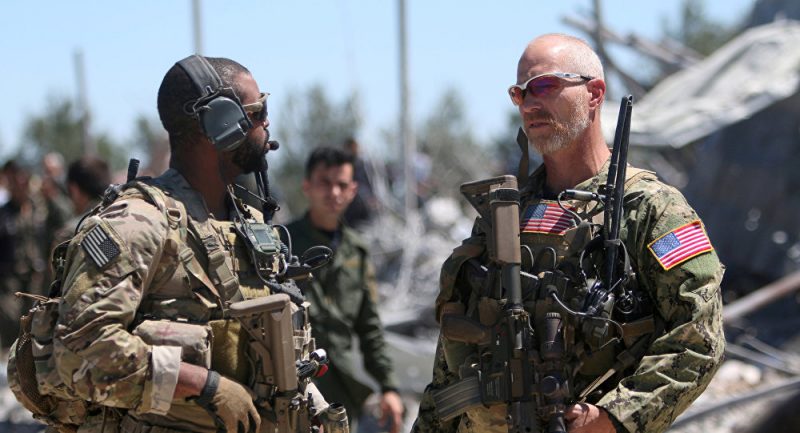
WASHINGTON (Reuters) – President Donald Trump has begun what will be a total withdrawal of U.S. troops from Syria, declaring on Wednesday they have succeeded in their mission to defeat Islamic State and were no longer needed in the country.
A decision to pull out completely, confirmed by U.S. officials and expected in the coming months, coincides with the roughly 2,000 U.S. troops finishing up a campaign to retake territory once held by Islamic State militants.
But it could leave the United States with few options to prevent a resurgence of Islamic State. It could also undercut U.S. leverage in the region and undermine diplomatic efforts to end the Syrian civil war, which is now in its eighth year.
“They’re all coming back and they’re coming back now. We won,” Trump declared on Wednesday in a video posted on Twitter.
After historic victories against ISIS, it’s time to bring our great young people home! pic.twitter.com/xoNjFzQFTp
— Donald J. Trump (@realDonaldTrump) December 19, 2018
News of a full withdrawal drew immediate criticism from some of Trump’s fellow Republicans, who said that leaving strengthened the hand of Russia and Iran, which both support Syrian President Bashar al Assad.
It may also leave exposed an alliance of Kurdish and Arab militias known as the Syrian Democratic Forces, or SDF, which has been among the most effective against Islamic State but is under threat as Turkey weighs a new offensive in Syria.
U.S. commanders on the ground, who have developed strong ties to SDF leaders, had voiced concerns about what a fast withdrawal would mean for the U.S-backed forces and were surprised by the decision, U.S. officials told Reuters, speaking on condition of anonymity.
But Trump said that he considered the mission in Syria over given Islamic State territorial losses.
Trump’s predecessor, Barack Obama, was slow to get involved in Syria’s civil war, fearing being dragged into another open-ended foreign conflict like the one in Afghanistan. Hundreds of thousands of people have been killed in the conflict, which has displaced around half of Syria’s pre-war 22 million population.
But in a campaign to defeat Islamic State in Syria, Obama ordered air strikes from September 2014 and then troops into the country the following year.
The White House declined to offer a timeline for withdrawal.
One U.S. official said Washington aimed to withdraw troops within 60 to 100 days and said the U.S. State Department was evacuating all its personnel in Syria within 24 hours. A second official said they could leave even sooner.
TRUMP’S WARINESS
Trump is wary of open-ended foreign conflicts and his decision on Syria raises questions about whether he may also reconsider the U.S. war effort in Afghanistan, where American forces have been fighting since 2001.
Trump reluctantly agreed to a troop increase last year but U.S. officials have privately acknowledged a sense of urgency and are increasingly focused on securing a peace deal with a resurgent Taliban.
Some of Trump’s Republican allies in Congress railed against the pullout decision. U.S. Senator Lindsey Graham, often a Trump ally but generally a foreign policy hawk, said a withdrawal would have “devastating consequences” for the United States in the region and throughout the world.
“An American withdrawal at this time would be a big win for ISIS, Iran, Bashar al Assad of Syria, and Russia,” Graham said in a statement, using the acronym ISIS for Islamic State.
The surprise decision also raised eyebrows abroad.
A British defense minister said he strongly disagreed with Trump that Islamic State had been defeated in Syria. Israeli Prime Minister Benjamin Netanyahu said Israel would study the decision and would ensure its own security.
In Russia, TASS news agency quoted the Foreign Ministry as saying withdrawing U.S. troops from Syria created prospects for a political settlement.

SPECIAL FORCES
Many of the remaining U.S. troops in Syria are special operations forces working closely with the SDF.
The partnership with the SDF has helped defeat of Islamic State in Syria but has outraged NATO ally Turkey, which views Kurdish YPG forces in the alliance as an extension of a separatist militant group fighting inside Turkey.
Ankara is threatening a new offensive in Syria. To date, U.S. forces in Syria have been seen as a stabilizing factor and have somewhat restrained Turkey’s actions against the SDF.
A complete withdrawal of U.S. troops from Syria would leave a sizeable U.S. military presence in the region, including about 5,200 troops across the border in Iraq. Much of the U.S. campaign in Syria has been waged by warplanes flying out of Qatar and other locations in the Middle East.
Still, Defense Secretary Jim Mattis and State Department officials have long fretted about leaving Syria before a peace agreement can be reached.
Islamic State is also widely expected to revert to guerilla tactics once it no longer holds territory. The United States has not ruled out that Islamic State’s leader Abu Bakr al-Baghdadi could still be alive.
A U.S. withdrawal could open Trump up to criticism if Islamic State reemerged.
Trump had lambasted Obama for the withdrawal of U.S. forces from Iraq that preceded an unraveling of the Iraqi armed forces. Iraqi forces collapsed in the face of Islamic State’s advance into Iraq in 2014.
A senior administration official rejected the comparison to Iraq, where the United States had many more troops and would have stayed if Baghdad had provided legal protections for the American forces.
“That’s an apples and oranges comparison given the scope and scale of our engagement in Iraq,” the official said.

LAST 1 PERCENT
Islamic State declared its so-called “caliphate” in 2014 after seizing large swathes of Syria and Iraq. The hardline group established its de facto capital in the Syrian city of Raqqa, using it as a base to plot attacks in Europe.
According to U.S. estimates, the group oversaw about 100,000 square kilometers (39,000 square miles) of territory, with about 8 million people under Islamic State control. It had estimated revenues of nearly one billion dollars a year.
A senior U.S. official last week said the group was down to its last 1 percent of the territory it once held. It has no remaining territory in Iraq.
Hajin, the group’s last major stronghold in Syria, is close to being seized by U.S.-backed SDF forces.
After losing Hajin, Islamic State will control a diminishing strip of territory along the eastern bank of the Euphrates River in the area where U.S.-backed operations are focused. Militants also control some desert terrain west of the river in territory otherwise controlled by the Damascus government and its allies.
U.S. officials have warned that taking back the group’s territory would not be the same as defeating it.
“The Coalition has liberated the ISIS-held territory, but the campaign against ISIS is not over,” Pentagon spokeswoman Dana White said in a statement.

By Idrees Ali and Phil Stewart
(Reporting by Phil Stewart and Idrees Ali; Additional reporting by Eric Beech, David Alexander, Doina Chiacu, Steve Holland and Roberta Rampton in Washington and Sarah Dadouch in Istanbul; Writing by Phil Stewart and Arshad Mohammed; Editing by Frances Kerry and Grant McCool)
The 21st Century
